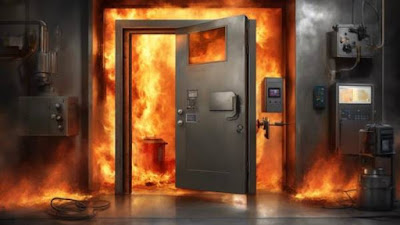A Comprehensive Guide from Leading Manufacturers
Picture a door that refuses to give in when flames roar; that’s a fire door in a nutshell. Built from hardy, fireproof materials and slammed shut in countless lab tests, it stands guard between rooms in a building. You’ll usually see a label that reads FD30 or FD60, with a straightforward code for how many minutes the door can keep a blaze at bay in a tight, controlled trial. The number beside the FD is no marketing gimmick; it is the measured interval a fire can pound away without punching through. Click here to read more about the fire doors manufacturer – YK
A Fire Door Job in an Emergency
When smoke starts to crawl across a hallway, that door suddenly becomes a lifeline. Splitting the corridor in two buys frightened people extra seconds to reach a staircase or, if luck holds, the street outside. Good lighting, clear signs, and that stout door work as a team; the signs say go, the door says stay out-for-now. Swelling strips tucked into the frame eventually swell up in the heat, closing off even the tiniest crack where both fire and hot smoke love to sneak. In the end, the door pins the damage into a single room, sparing the rest of the building from an uncontrollable outbreak.View the fire doors manufacturer – YK details to get into the details
The Role of Fire-Rated Doors in Property Protection
More than just lifesavers, fire-rated doors stand guard over everything that money cant replace. By pinning a blaze to one room, they spare machinery, paperwork, and even the very frame of the building itself. That tight hold on the flames shrinks potential losses and gives firefighters a fighting chance in calmer circumstances. Kept in good repair and fitted squarely into a wider fire plan, these doors remain one of the first-line bulwarks demanded by safety codes and common sense.
What Are the Different Types of Fire-Rated Doors?
Steel Doors vs. Wooden Fire Doors
Steel fire doors set the benchmark for sheer toughness. Hostile temperatures batter them, yet they rarely buckle and seldom warp. A reinforced core is often standard, turning the threshold into a long-winded barrier that lets emergency crews do their job. Factories and city high-rises tend to lean on this category because the steel can shrug off a furnace-like heat for hour after hour. Wooden fire doors came up the hard way, tagged as old-school until manufacturers started wedging fire-retardant paste and intumescent strips inside the frames. The raw toughness still trails behind steel, yet many models now flirt with a 90-minute rating and sometimes push past that edge. Builders favor the look, and because the oak or maple veneer can vanish into a vintage corridor, these doors keep turning up in hotels, schools, and the odd historic courthouse.
Fire-Rated Glass Doors: A Contemporary Approach
Fire-rated glass doors pair modern aesthetics with genuine fire safety. The glass itself receives special thermal treatments that keep flames, smoke, and extreme temperatures at bay for predetermined intervals. Architects favor these installations in open-plan offices, upscale residential lobbies, and transit terminals because the paneling preserves light and sightlines, two qualities that steel or gypsum barriers handicap. Builders can specify steel or anodized aluminum framing to match durability needs without sacrificing visual coherence.
Understanding 20-Minute to 3-Hour Ratings
Door ratings are marked by the duration, measured in minutes or hours, that the assembly can endure direct flames. A 20-minute assembly slows a fire’s advance long enough for people to clear the space and for firefighters to arrive; that delay matters in corridors or stairwells with modest risk profiles. In contrast, 90- and 180-minute constructions guard areas where high-value assets or mission-critical operations demand longer protection, automatically steering incidents toward other zones of the building.Heavy-duty, three-hour fire-rated doors are designed for the most demanding settings, including boiler rooms and certain manufacturing plants where sparks and heat are routine. Their steel-and-sandwich construction withstands flames and near-full-blown collapse long enough for everyone inside to retreat. Certification bodies subject each prototype to twelve or more unbroken hours of furnace probing, so the final rating means something on the final day it is needed. Choosing one of these portals remains an act of foresight rather than emergency triage, because once the blaze roars, there is seldom time to ask which model was on the shelf.
How to Choose the Right Fire Door Manufacturer?
Key Features to Look for in a Manufacturer
Choosing a fire-door maker is not just another line-item decision; it is a matter of proven know-how, consistent quality, and day-in, day-out reliability. The doors must shrug off real heat and still fit the strict testing protocols that the industry demands, so durability is non-negotiable. Look for manufacturers using cutting-edge, fire-resistant cores and skins, because yesterday’s chemistry quickly becomes another headline. Precision assembly matters too; if the gaps are even a credit card wide, the enclosure loses its nerve. Custom options, whether a borrowed oak veneer or an oddball frame size, let a project keep its personality without sacrificing life safety.
Importance of Compliance with NFPA Standards
NFPA compliance is not a marketing badge- it is the contract between a door and the worst moment you pray never arrives. Regulations like NFPA 80 spell out how the hardware, the frame, and the panel itself must behave from the first spark to the last orderly exit. A manufacturer that checks those boxes is handing you more than paperwork; they are giving the legal protection that auditors and courts will look for tomorrow. Meeting the code simply lowers the odds; doing it with integrity keeps people safe when luck runs out.
Why Certification Matters for Fire Doors
A fire door that carries a formal certification has already survived the worst kind of trial-by-fire. Independent laboratories, not the manufacturer, expose the door to heat, smoke, and pressure, then record exactly how long it holds up. Those controlled tests create the stamp of approval that proves the door meets its promised fire-resistance rating. When building owners lean on that stamp, they are not guessing; they know the product has met national safety codes and that, if disaster strikes, the door will do its one vital job.
Applications of Fire Doors in Commercial and Industrial Settings
Common Applications in Commercial Buildings
Fire doors occupy a non-negotiable role in offices, hospitals, universities, and even large shopping centres. When properly deployed, they compartmentalize heat and smoke, buying time for people to evacuate and for firefighters to arrive. High-rise towers, for example, almost always line their stairwells and corridors with steel-framed smoke doors so escape routes remain tenable until the last possible moment. Retail outlets, in contrast, use them to seal off stockrooms, thereby protecting customers on the floor from fumes or flame.
Such measures not only meet local and national fire codes, but they also represent a straightforward investment in human safety and property preservation.
Fire Door Options for Industrial Sites
Manufacturing floors, shipping warehouses, even power-generating plants see plenty of sparks and fumes, so a serious fire plate isn’t a luxury; it’s routine. Heavy gear sits alongside pallets of flammable stock, and that mix boosts the odds of an emergency erupting. Robust industrial doors step into the breach. The panels are built to shrug off intense heat for hours, giving people time to clear and allowing firefighters a fighting chance. Strategically hung between shop lines, bulk-storage bays, and chemical holds, the doors carve out safety zones that protect both workers and mission-critical machines. In short, they sit at the heart of any sensible risk plan and keep operations on an even keel when the smoke starts.
Fire Doors in Residential Settings
Even in the everyday apartment block or the ordinary row house, a well-rated fire door can mean the difference between an unsettling scare and a serious disaster. In many mid-rise condos, such doors guard the threshold of each unit, seal off busy hallways, and protect narrow staircases, all while pinning the flames to one floor. In the classic single-family bungalow, the heavy slab might slide into the opening between the garage and the mud room, or wedge itself across a cluttered utility closet where old paint cans quietly wait. Beyond far-fetched what-ifs, most local building codes now count these doors toward the checklist and, by extension, so do the relieved hearts of tenants and weary landlords.
What Standards and Codes Govern Fire Doors?
Understanding Fire Door Compliance Codes
Compliance codes for fire doors exist to create an equal baseline of safety across homes, offices, factories, and public spaces alike. The rules are intended to ensure that any door labeled fire-rated does indeed slow the horizontal march of flames and the near-invisible drift of smoke when panic strikes. National Fire Protection Association documents, such as NFPA 80, spell out every detail from frame material to monthly checks, so no part of a door’s life is left to guesswork. Alongside those national mandates, the International Code Council and local permit offices insert their own tweaks, making the final checklist a patchwork but necessary bulwark against disaster.
How Codes Impact Design and Manufacturing
Fire-safety regulations exert a powerful shaping force on door design and factory assembly. Each clause in a given code coaxes engineers to rethink materials, geometry, and finishing touches long before the first prototype is hung in a lab. Testing protocols such as ASTM E152 or UL 10C hurl flame and heat at full-scale specimens, demanding that hinges, cores, and skins endure without buckling or leaking beyond strict time limits. Beyond survival in a furnace, a finished door must still swing freely for the person caught on the opposite side when the alarm sounds. That practical need nudges designers toward self-closers, tight smoke seals, and readable markings that survive both panic and plate-glass lawsuits. In brief, codes blend numeric rigor with everyday usability, turning a simple slab of wood or steel into a certified barrier against fire.
The UL mark you see on the edge of a fire-rated door means someone has already done the hard testing to prove this door can actually slow the spread of flames. That little sticker carries more than a logo: it spells out the doors’ hourly rating, names the responsible lab, and delivers a manufacturer imprint you can track back to the factory floor. Building inspectors and facility staff memorize that label number on the fly so they can sign off on code compliance during an afternoon walk-through or clear one last hurdle before an occupancy permit is issued. When the alarm finally rings, to no one’s surprise, really, and the slab swings to, the certified assembly behaves according to its paperwork, keeping people calm and giving firefighters a fighting chance.
How to Maintain Fire Doors for Optimal Performance?
Routine Inspections and Maintenance Duties
Keeping fire doors in sound condition demands more than a yearly glance; it requires disciplined upkeep. Building codes usually stipulate an annual examination, yet corridors choked with foot traffic often need a quarterly or monthly check. Inspectors look at the frame for cracks, the hinges for play, the closer for snags, and the gaskets for rotting. Repairs might be as simple as tightening screws or applying lubricant, though really damaged parts must be swapped out. Every action, from a minor oiling to a hinge replacement, should be logged so the paper trail proves compliance with safety regulations.
Typical Defects and Their Remedies
Age rarely spares anything, and fire doors are no exception; wear reveals itself in a grab bag of familiar problems. A door may swing wide but refuse to latch, or it may hang crooked with a gaping quarter-inch gap. Fixing misalignment usually means adjusting the hinges, while a torn gasket cannot be patched and must be replaced to preserve its barrier. A closer that drags or omits the final snap needs either an overhaul or a complete swap; half measures invite disaster. Alterations such as drilling new locks or shaving the bottom edge, though tempting for quick fixes, cancel the rating and must be reversed if safety is the priority.
Fire Door Safety and Regulatory Conformance
Fire doors are a last line of defense, so their installation should track manufacturer specifications and any governing statutes, including NFPA 80, where U.S. buildings are concerned. Each door must still display its UL label or recognized mark to indicate it has withstood formal testing. In-house crews benefit from routine workshops that refresh them on handling procedures and current code shifts. Periodic evaluations by certified inspectors provide a second opinion on each door’s structural soundness and regulatory standing.















![[dok. Humas PT PP Properti Tbk]](https://infoaceh.net/wp-content/uploads/2025/06/679334e941763-fasilitas-lengkap-pp-properti-hadirkan-hunian-student-residence-di-margonda-depok_665-250x144.jpeg)






















